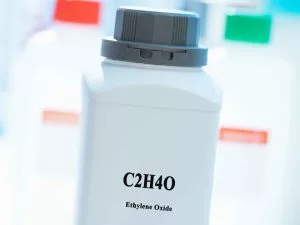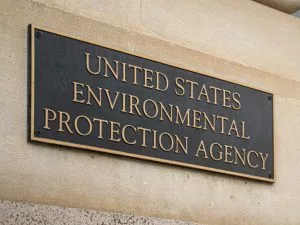
For the last 50 years, EPA has buckled to pressure from the chemical industry, and basically done nothing to protect millions of Americans from breathing a life-threatening, cancer-causing chemical known as “ethylene oxide” (ETO). Along the way, EPA even repeatedly violated federal law – the “Clean Air Act” – by refusing to periodically make rules necessary to protect Americans against dangerous chemicals like ETO.
Let me say that again: EPA repeatedly violated the law. And it did so to benefit the corporations that profit from making, selling, using, and polluting with ETO.
Finally, on March 14, 2024, after being pressured by a lawsuit from environmental champion, Earthjustice, to force EPA to simply obey the law and protect us from ETO, EPA announced a rule requiring that US sterilization plants reduce their ETO emissions by 90%. ETO gas is used in the sterilization process to kill living things like bacteria, for example, found on the medical and other devices being sterilized.
ETO is an effective sterilant because it’s really good at killing living things. Here’s the problem: ETO can also cause cancer in people who inhale it. And after it’s done killing in the sterilization plant, the waste carcinogenic ETO gas is pumped out vents in the sterilization plant’s roof, left to blow in whatever direction the wind takes it – sometimes to nearby homes, school, parks, etc.
Worse still, ETO gas is colorless and odorless. So those breathing ETO don’t know it. And for the vast majority of US sterilization plants, until recently, no one warned local residents, parents, school children, etc., that a cancer-causing chemical was in the air they were breathing. This failure to warn is inhumane, with potentially devastating consequences: nearly 14 million people in the US and Puerto Rico live within 5 miles of a sterilization plant.
March 14’s EPA rule is said to be aimed at protecting residents near these plants. Especially the children, whose small bodies make them particularly vulnerable to ETO’s terrible consequences. EPA says this rule is an example of how the federal government protects us from environmental dangers.
But it is not. In fact, it is exactly the opposite. The truth is that the rule is an example of how government delay in protecting people – typically, as in the case of ETO, the result of corporate muscle and influence – causes intolerable suffering among those who most need and deserve government’s protection. And who, in most instances, are paying for that protection – in the form of their taxes.
The fact is that the federal government had known since at least 1977 that ETO can kill more than bacteria – it can kill humans, too. And yet 2024 is the first time ever that EPA made a rule meaningfully restricting – not eliminating, mind you – ETO emissions.
EPA is not a “protector of the people. “A protector of the corporations that make, sell and sterilize with ETO,” is a far more fitting title.
The sadly unanswerable question must nevertheless be asked: how many people living near these plants during the last 50 years have paid with their lives and health trusting that their government would warn them about the ETO they were breathing, let alone protect them against it?
Here is just some of what the EPA and the federal government knew about the cancer-causing properties of ETO long before 2024:
But none of this moved EPA to make a rule meaningfully restricting the use of ETO.
Despite this ominous proof of ETO’s threat to human life, the federal government then basically went to sleep on ETO for 35 years. During that time, it watched the proliferation throughout the US of sterilization plants that were spewing their waste ETO gas into residential communities. The people living, working, and going to school in those communities had no idea that a chemical as dangerous as ETO was getting into their lungs, let alone how dangerous it was when it got there.
Then, in 2016, largely based on evidence that had been available to the agency for decades, EPA announced the results of its long-overdue study on ETO. The study concluded:
Yet its own 2016 study caused no emissions-cutting rule from EPA.
In 2018, the Agency for Toxic Substances Disease Registry (ATSDR), studied the impact of ETO emissions in the residential community of Willowbrook, IL, in west suburban Chicago. The ATSDR study concluded:
This was the first time the people of Willowbrook had ever been told what they were breathing in their community’s air for the last 30 years. At that same time, EPA also announced that among the communities in the US with “unacceptable risk” for cancer were those with ETO-spewing sterilization plants.
In fact, one of the very worst cancer-risk communities in the US was the one immediately surrounding the ETO plant in Willowbrook, Illinois.
Still no emissions-cutting rule from EPA.
Understandably, the ATSDR report provoked shock and outrage in the previously ignorant residents of Willowbrook. This was especially true because of the prevalence in the area surrounding the sterilization plant of women with breast cancer – the cancer most strongly connected to ETO inhalation in the 2016 EPA study. More than 800 Willowbrook area people sued the operator of the Willowbrook sterilization plant, claiming that their cancers, or the cancers of a deceased loved one, had been caused by years of unknowing inhalation of the plant’s ETO.
More than 600 of these plaintiffs were area women with breast cancer. The case was known as In re Willowbrook Ethylene Oxide Litigation. (Willowbrook Litigation).
In February 2019, with an outraged local citizenry demanding answers from the sterilization plant’s operator, and the State of Illinois regulator asking hard questions for the first time in 35 years about cutting ETO emissions from the plant, the operator – frightened of the scrutiny – pulled up stakes and left town…rather than explain itself to residents, and drastically cut ETO emissions.
And still no emissions cutting rule from EPA.
In September of 2022, the first case in the Willowbrook Litigation went to trial. It involved a woman (Susan Kamuda) who had unknowingly inhaled the plant’s ETO for 22 years at her home 3 blocks away before she was diagnosed with breast cancer. After a 6-week trial, the jury awarded damages of $363 million. Extraordinarily, $325 million of the verdict was for “punitive damages,” reflecting the jury’s outrage at the years-long conduct that had led to Kamuda’s breathing such a dangerous chemical for decades without being given so much as the decency of a warning.
It was, and remains, the largest single plaintiff jury verdict in the 150+ year legal history of the State of Illinois.
Shortly after the Kamuda verdict, in December of 2022, Earthjustice sued EPA. Earthjustice noted that, despite the Clean Air Act’s requirement that EPA limit ETO emissions, and periodically review and revise ETO emission standards as necessary to protect human health, EPA had not done this, and was indeed violating the law.
Within months of the Kamuda verdict, the sterilization plant operator in the Willowbrook Litigation settled with the 800+ cancer victim plaintiffs by agreeing to pay them more than $400 million.
Neither the massive Kamuda verdict nor the massive settlement payment from the Willowbrook ETO plant operator moved EPA to declare an emissions-cutting rule.
Until now. Years too late for the Willowbrook cancer victims.
****

EPA’s half-century of callous neglect of the lives and health of millions of Americans breathing ETO is both shocking… and, sadly, routine. It is shocking because the agency that we pay and expect to protect us from ETO has betrayed us: it has seemed so often to be working for the other side, the one causing the threats.
But it is also routine. Because, while the story above may be nominally about ETO, the names of many other similarly toxic chemicals could be substituted for ETO, and the story would not change much. Chemicals such as PCB’s; the PFAS chemical family; TCE; asbestos; and mercury – where EPA has badly delayed or failed altogether to protect Americans from the threats of which the agency had long been aware. And this is to say nothing of the nearly 60,000 chemicals permitted to be on the market in the US despite absolutely no assessment of their risks to human health.
EPA’s working philosophy is that a chemical is “safe until proven dangerous.” Or sometimes “too safe to regulate, even after it’s proven dangerous.” That’s the story of ETO.
The bottom line of these enraging American stories does not change: the financial and political power of the chemical industry overwhelms and corrupts our scientific, legislative, and regulatory processes. Our government – EPA is but one example – mobilizes to protect the operations and profits of industry. And the lives and health of Americans are systematically sacrificed in the process.
Beginning in 2018, author Shawn Collins, along with Collins Law Firm colleagues, Ed Manzke and Maggie Galka worked with a team of lawyers to lead the fight for more than 800 residents of the Willowbrook, IL, area who had contracted cancer after unknowingly breathing a carcinogen known as ethylene oxide (EtO) for many years. The residents’ cases were consolidated into one mass litigation in Cook County (IL), In re Willowbrook Ethylene Oxide Litigation, Case No. 18 L 10475, before Judge Marguerite Quinn.
In recognition of his 20 years of environmental litigation experience, Shawn was appointed a co-lead of the Plaintiffs’ Executive Committee (PEC).
Shawn and Maggie served as co-counsel in the first trial, Kamuda, et al., v. Sterigenics U.S., LLC, et al., for Plaintiff Sue Kamuda, a breast cancer victim. On September 19, 2022, the jury returned Illinois’ largest-ever single plaintiff verdict against the defendants: $363 million. $325 million of the verdict (90%) was for punitive damages – an extraordinary repudiation of the defendants’ reprehensible conduct. Within months of the Kamuda verdict, the Willowbrook operator agreed to settle with the cancer victims by paying more than $400 million.

"*" indicates required fields